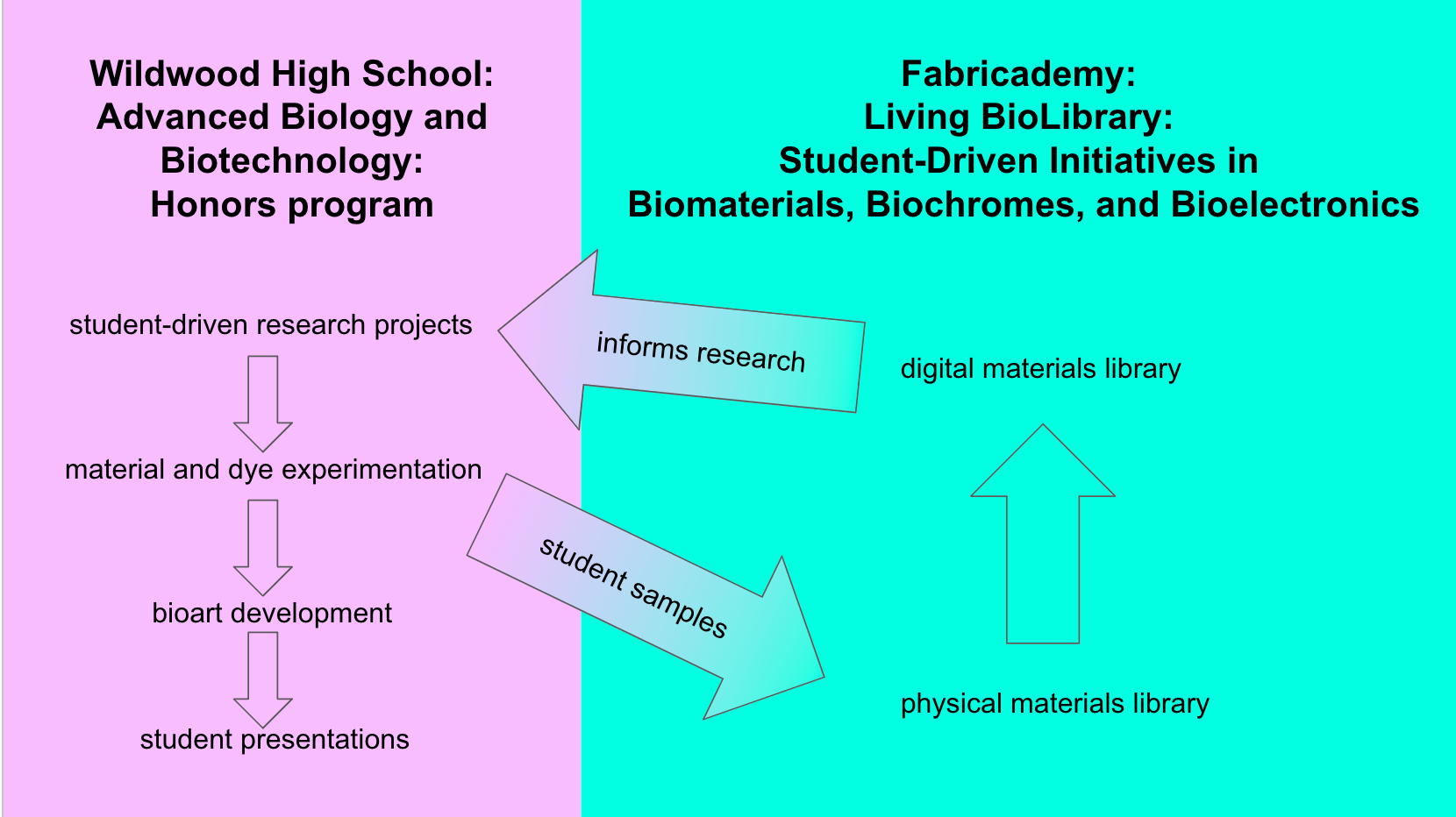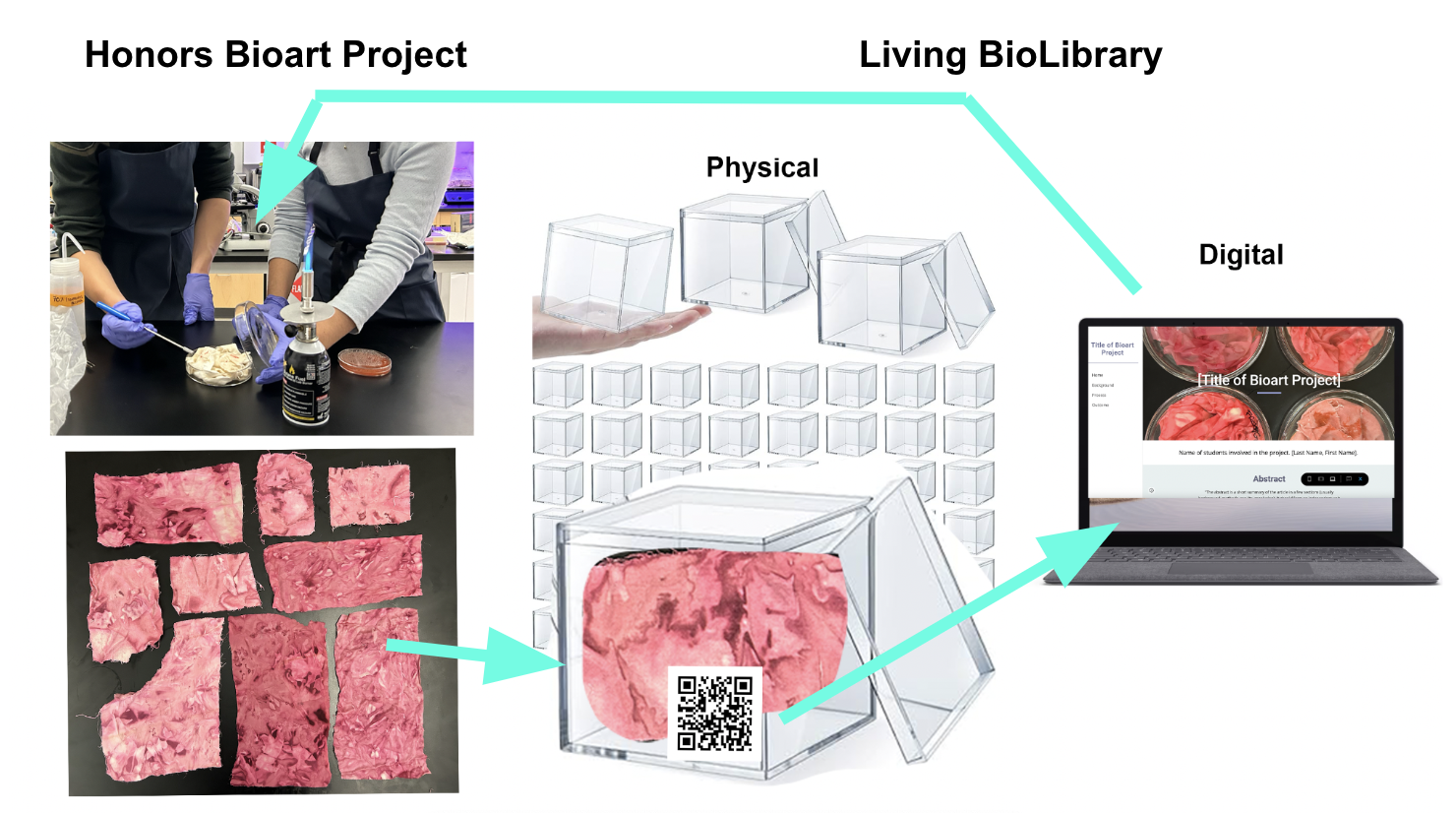Concept | Living BioLibrary: Student-Driven Initiatives in Biomaterials, Biochromes, and Bioelectronics¶
Project Overview¶


5 Ws who, what, when, where, why¶
who¶
High school students, grades 11-12, enrolled in the Honors program of my Advanced Biology and Biotechnology course.
what¶
I aim to create a classroom materials library where students can add swatches during their bioart project development, serving as a resource for future years. This will be a living, student-driven library. This materials library will be developed in conjunction with a student-driven research project as part of the Honors program for the course.
Advanced Biology and Biotechnology course
Honors program: an optional educational initiative designed for students seeking additional academic challenges and opportunities for intellectual growth.
Bioart Research Project:
This Honors Bioart Project spans three-months in which students design, develop, and create a piece of bioart that they showcase at Science Night—an open house event for the community. The driving question for this project is “How might bioart inform sustainable practices?”
First, students choose a topic of interest from several different paths. For instance, in the previous year, students could choose among three paths: biofabricating materials, experimenting with natural dyes, and building organism-interfacing electronic devices. Within each path, I offer examples of specific bioart projects for students to consider. Those with ambitious ideas are also encouraged to innovate their own designs. Furthermore, students have the flexibility to work either independently or in a group. This freedom enables them to select a project aligned with their interests and work in a style that suits them best.
The Honors Bioart Project guides students through the scientific process including a lab report-style write-up. The project is broken down into a structured timeline with mini-deadlines. This ensures that students spread out the workload and also allows for multiple rounds of iteration. After each mini-deadline, I provide students with feedback so that they may improve their work. Below I have summarized the expectations for each mini-deadline to provide insight into the extensive exploratory journey the students undertake.
Mini-deadline #1, Background: Students start researching their topic of interest and begin to collect resources for their references section. Students write an introduction to their topic including background information of what previous studies have done, gaps in the field, and how they might address those gaps in their project. Students also begin the ideation process, developing sketches or models of their final product.
Mini-deadline #2, Planning: Students practice backwards planning and project management skills. They develop a detailed timeline, compile a list of materials, and write down all necessary procedures.
Mini-deadline #3, Process: Students have a month of dedicated in-class work time to physically experiment with materials, utilize digital fabrication tools like laser cutters and 3D printers, and work towards creating their final bioart product. They also contribute to the class materials library by creating a swatch of the material or dye used.
Mini-deadline #4, Outcome: Process is emphasized over product here. Students finalize their documentation. Students reflect on the process through discussion on their creative process, challenges faced, and how their bioart project fits into the driving question.
Science Night: At Science Night, students present their projects to the community.
Living BioLibrary
Students will provide swatches of their innovations which will be housed in a physical library.
Physical Library
This physical library will consist of clear acrylic boxes in which student-made materials will reside. Boxes will have a QR code sitcker that can be scanned to bring people to the digital library (see below). Boxes may be stacked and attached to each other through velcro stickers. There are multiple purposes of stacking the boxes: 1) display purposes 2) students can bring boxes to their desks during ideation phase 3) students can organize boxes across caterogies 4) materials protected from elements.
Digital Library The QR code on the physical box sends students to the Living BioLibrary website. This website will house open-source information on the following for each box: 1) biological information about the organism used 2) how the product is connected to sustainable practices 3) materials and methods 4) examples of student bioart projects.
when¶
The Honors Bioart Project occurs in the second semester (Dec - April).
where¶
Wildwood High School
why¶
To create a resource for students within the school community with the hope to expand it to the broader community.
Moodboard¶
 Images left to right: Dr. Martin Luther Kin, Jr. Library, Department of Entomology, National Museum of Natural History, Bio-Art Science and Art in Harmony article
Images left to right: Dr. Martin Luther Kin, Jr. Library, Department of Entomology, National Museum of Natural History, Bio-Art Science and Art in Harmony article
References projects, research papers, expos, performances etc¶
Material Archive promo - by Maria Viftrup
Material Archive promo - by Maria Viftrup from Makers of Waag on Vimeo.